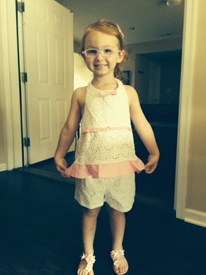Diagnosing Retinoblastoma
A diagnosis of retinoblastoma is made by examining the eyes. A white pupil or strabismus (crossed eyes) will usually be noticed by a parent or pediatrician. Because this disease is relatively rare, children are typically referred to a special ophthalmologist who is familiar with the treatment of retinoblastoma. The child may need to be examined under general anesthesia to define the extent of the tumor in the eye(s) and to record the information in photographs or diagrams. The specialist may also use additional tests to detect tumors. The following tests are commonly used to provide the specialist with a picture of the inside of the eye and the brain:
Children diagnosed with retinoblastoma will require a complete physical examination. If there are any symptoms or abnormal findings, the child may also need additional tests to see if the cancer has spread to other parts of the body. Tests that may be performed include:
Children and families may also be referred for genetic testing and counseling.
Expand all sections Close all sections
Staging
After retinoblastoma has been detected, the doctor will determine the extent of disease in the eye and the presence of disease outside of the eye. This is called staging, and it helps the doctors plan the appropriate treatment. Two staging systems are used for retinoblastoma, one for assessing the amount of disease inside of the eye which correlates with the probability of saving the eye and vision, and another system that evaluates the presence of disease outside of the eye. For staging the eye, the International Classification for Intraocular Retinoblastoma is used. This classification system uses a letter (A-E) to signify the extent of the disease; the more extensive the child’s disease, the higher the class. This designation will determine the treatment that will most effectively cure the cancer and preserve the child’s sight.
Group A
- Small tumors (less than 3 mm) that are confined to the retina and more than 3 mm away from the foveola and more than 1.5 mm away from the optic disk
Group B
- Tumors larger than 3 mm that are confined to the retina in any location
- Clear subretinal fluid less than 6 mm from the tumor margin
Group C
- Localized vitreous and/or subretinal seeding (less than 6 mm from the tumor margin)
- No tumor masses, clumps or snowballs in vitreous or in the subretinal space
Group D
- Diffuse vitreous and/or subretinal seeding (less than 6 mm from tumor)
- Subretinal fluid more than 6 mm from tumor margin
Group E
- No visual potential OR presence of any one or more of the following:
- Tumor in the anterior segment
- Tumor in or on the ciliary body
- Neovascular glaucoma
- Vitreous hemorrhage obscuring the tumor or significant hyphema
- Phthisical or pre-phthisical eye
- Orbital cellulitis-like presentation
Doctors use several systems to evaluate the amount of disease outside the eye. However, the most important points are to see if the retinoblastoma has spread outside of the eye into the orbit or the optic nerve, and if it has spread into the brain or elsewhere in the body (bones, bone marrow or liver).
Causes of Retinoblastoma
There are two main types of retinoblastoma, a heritable genetic form and a non-heritable form. More than half of the children diagnosed with retinoblastoma have the non-heritable form of the cancer. Most children (85%) with the genetic form do not have a parent with retinoblastoma; however, the change in the gene occurred in either the egg or the sperm of one parent prior to conception. If a child has the genetic form of retinoblastoma and neither parent has the tumor, the chance that retinoblastoma will occur in another child in the family is less than 5%. However, the risk of tumor in the offspring of a child with the genetic form of retinoblastoma is about 50%. In children with the heritable form of retinoblastoma, it is common for the cancer to affect both eyes, or multiple tumors in either eye. Having the genetic form of the disease also increases a child’s risk of developing other cancers later in life.

